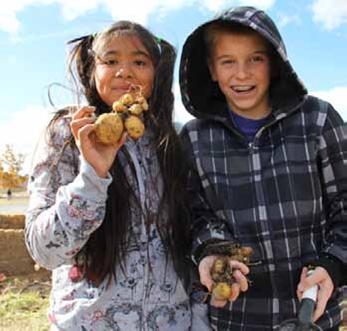
Three years ago, I was asked to participate in the White House Task Force on Childhood Obesity, out of which grew the First Lady’s Let's Move! initiative. In May 2010, we submitted a report to the President that made a series of recommendations for addressing the challenges of obesity and hunger, both of which stem from a lack of access to good, healthy food. The report identified local food systems as a strategy to combat food access problems, and specifically called upon the USDA "Know Your Farmer, Know Your Food" Initiative to provide technical and financial assistance to help communities grow and process their own food, and create jobs at the same time.
I’m pleased to report that we’ve made a lot of progress since 2009 – and we have two new tools to help communities learn about what we’ve done and tap into USDA resources to develop their own solutions. The new Know Your Farmer, Know Your Food Compass is a document packed with photos, video and case studies of communities building strong local food systems. Farmers’ markets, mobile produce vendors, farm to school initiatives, and food hubs are just a few of many examples highlighted by the Compass. The Healthy Food Access section shows how communities are using USDA resources to promote health and the local economy.
USDA also developed an interactive map showing USDA investments nationwide related to local food systems. You can sort the data by theme and identify projects on healthy food access. The map is a great way to see what’s happening in your own community and learn from other successful projects. Explore them, share them, and join the conversation over Twitter using the hashtag #KYF2.
The many success stories highlighted in the Compass show just how much progress our country is making when it comes to healthy food access. In New Haven, Connecticut, a city where one in four people live in poverty, a Business and Industry Guaranteed Loan from USDA helped construct the first full-service grocery store in the inner city in 2011. Elm City Market created 100 new jobs for local residents with salaries starting at twice the minimum wage. But the community didn’t stop there: the store is sourcing over half of its products from producers within 200 miles of the city. The store reports brisk business, serving community members that previously lacked access to the products grown just miles away from them.
Retail infrastructure like Elm City Market is just one way that USDA is expanding access to healthy, local food. Schools are another place where we’ve made tremendous progress – by investing in new school kitchen equipment to help cafeterias store and use more local food; by getting kids active in school gardens through our People’s Garden School Pilot; and by developing a toolkit for producers and school foodservice personnel on farm to school programs. KYF2’s Farm to School Team traveled to 15 schools around the country to learn about how they’re making change and document it in a summary report. You can read about this work and more in the Compass section on Farm to School initiatives. We will also be posting lots more stories on the Know Your Farmer, Know Your Food blog.
We’ve come a long way since 2009, but there’s no question that we still have miles to go. We can’t expand healthy food access if we limit ourselves to one or two strategies; it’s about using every tool in the toolbox to create community-specific solutions. Local food systems are one strategy with the potential to reap many benefits. I could not be more proud of the role USDA is playing in supporting this exciting, innovative, and life-changing work, nor more grateful for the strong support we receive from the First Lady and the President.
Kathleen Merrigan is the Deputy Secretary for the U.S. Department of Agriculture.


